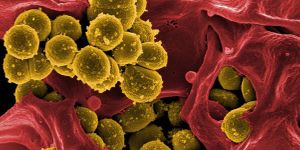Photon up-conversion for new cancer treatments
Scientists from the University of California, Riverside and The University of Texas at Austin have made a breakthrough in materials science that has significant implications for cancer treatments, solar-energy conversion, quantum information, and near-infrared driven photocatalysis. That’s quite a wide range of fields, isn’t it? Well, photon up-conversion is a big deal. In case you’ve never heard of it, watch the video below to learn more, but in summary, it refers to the emission of light with energy higher than the one that excites the material.
Photon up-conversion has been in the works for a while but always with the limitation of finding the right material. Silicon has been thought to be a potential option because it is nontoxic, but until this study, it was thought that silicon nanocrystals were incapable of up-converting photons. But the research, led by UC Riverside PhD student Pan Xia and published recently in Nature Chemistry, now shows otherwise.
As Xia explains, the research team went through a complex process in order to make it so that silicon nanocrystals would be able to up-convert photons through the attachment of special ligands (molecules attached to a metal atom by coordinate bonding). "We functionalized silicon nanocrystals with anthracene. Then we excited the silicon nanocrystals and found that the energy was efficiently transferred from the nanocrystal, through the anthracene molecules, to the diphenylanthracene in solution," said Xia. "It means we got higher-energy light."
Co-author Ming Lee Tang, who is an associate professor of chemistry at UC Riverside, continues: "To turn the low-energy photons into high-energy photons, you need to use triplets, you need to use quantum-confined nanoparticles, and you need to hold the nanoparticles and the organic molecules very close together. This is how you get the triplets to combine energy to get the high energy photons.” In other words, the organic molecules have to stick to the silicon nanoparticles in order to allow for photon up-conversion. And these researchers figured out how to make that happen. And not only did they figure out how to do this, but their method is actually quite fast and efficient, reports co-author Sean Roberts, who is an assistant professor of chemistry at The University of Texas at Austin.
Roberts and his fellow authors say that the potential for this finding is wide-ranging. They have no doubt that it will eventually lead to creating minimally invasive photodynamic treatments for cancer, in addition to improved photocatalysis, quantum information science, and singlet fission-driven solar cells.
Sources: Nature Chemistry, Science Daily








